Photos with this report (click to enlarge) | |||
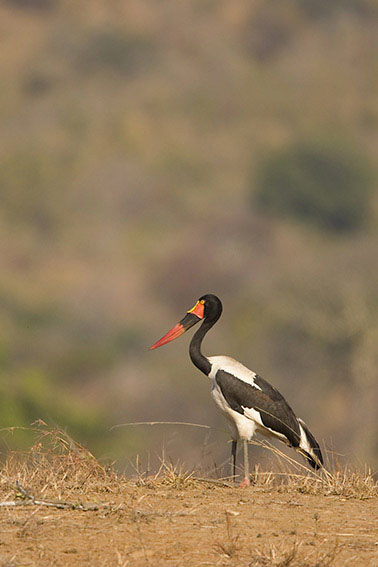 Saddle-billed Stork |
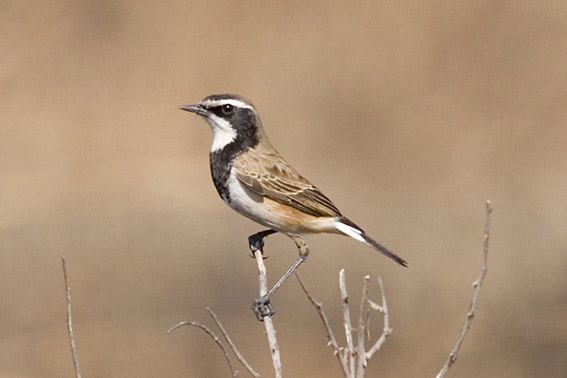 Capped Wheatear |
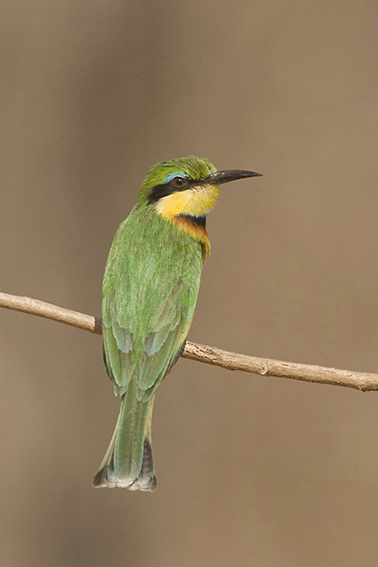 Little Bee-eater |
|
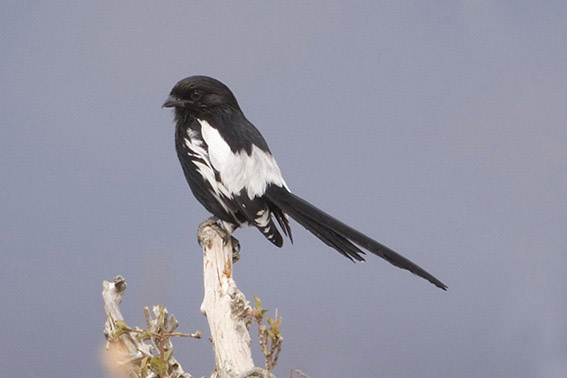 Magpie Shrike |
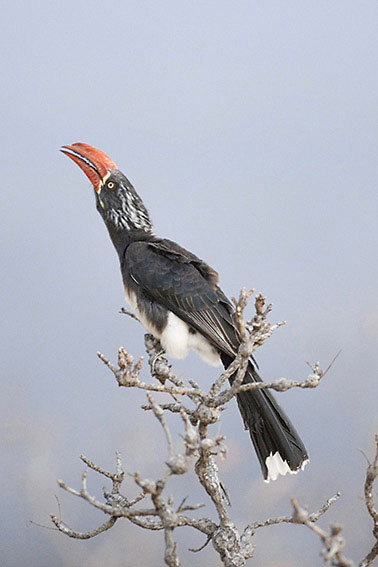 Crowned Hornbill |
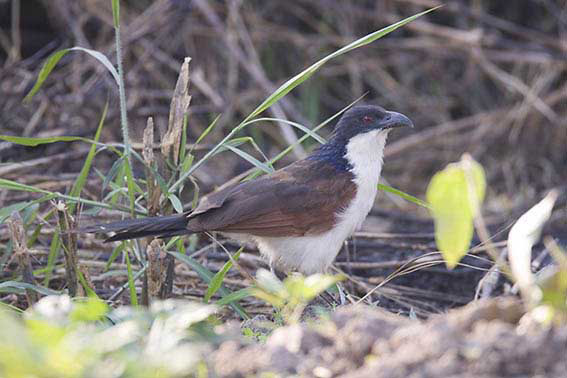 Coppery tailed Coucal |
|
For a full species account with a gallery of images visit my website www.norfolkbirding.com
General
This was a relaxed trip with daily bird watching & an element of game safari included. We covered a range of sites & habitats heading inland from Dar El Salaam to Ruaha over 2 weeks in the company of our friends Oscar Campbell & Gilly Ensor. The objective was to see some nice birds & game with plenty of opportunity to take images. There was some emphasis on seeing some of the scarcer birds & mammals, but it was not a tick & rush trip designed to see 400+ species!
If you want a laid back trip without driving 4-5 hours every 2-3 days you really need to emphasise this to the guides. Their tendency is to want to try & show you every last scarce bird/endemic & if that’s what you wish to do they will certainly accommodate you, however if not carefully check your itinerary & also add 25% to travel times as they tend to be a little on the optimistic side with some of these!
We then spent one week on the island of Pemba, just north of Zanzibar.
Tour Organisation
We organised the mainland trip & accommodation via a guide & driver using Chege Wa Kariuki [chege@birdwatchingeastafrica.com]. Cost of 14 days accommodation, transport food (simple food) & water around £1500.00 per person & represented very good value for money.
Please bear in mind the very competitive cost we achieved when reading my descriptions of the accommodation – it is possible to pay a lot more & improve on these, however we had some basic but also some very nice accommodation.
Chege is a very knowledgeable & enthusiastic guide, thoroughly recommended.
Birdwatching East Africa
4th Floor, Room 408, Pioneer Building, Moi Avenue
P.O. Box 2286, 00100- GPO Nairobi, Kenya
Tel: +254 (0) 20 201 4 724,
Cel: +254 (0) 722 329 570, 254 (0) 735 431 512
info@birdwatchingeastafrica.com
www.birdwatchingeastafrica.com Kenya, Uganda, Tanzania and Rwanda
Flights
We booked flights with KLM & flew from Norwich to Schipol, Amsterdam & on to Dar El Salaam. We booked our flight from Dar to pemba with Coastal Aviation web: http://www.coastal.cc/. 12 seater planes quite a nice experience! KLM thoroughly recommended! Excellent food, service, free drinks & individual screens with a wide choice of entertainment. A stark contrast to the very poor flight & service to India at Xmas provided by Monarch Airlines.
Itinerary & Accommodation
Accommodation once around the parks varies from the very basic to the exuberant, the latter choice is likely to effect the weight of your wallet significantly. We had a real mix, so to help I have provided a brief review of each accommodation. If you haven’t been to Africa then please realise that hot water, hot food, fast food are not always guaranteed in the simpler lodges!
Day 1: Arrive Dar: Flight KL0567 from Amsterdam landing at 22.25 (Sunday 25th July)
Accommodation: Hotel Mediterraneo
Food: Very good
Rooms: Good
Location: Very Good, sea front
Day One: Bird watched briefly along the seafront before departing for Mikumi, there is a good area of gardens & river estuary just walking north of the Mediterraneo along the beach for 30 minutes. Lots of shorebirds, waders, plus passerines on the rough ground & gardens.
Stopped en-route in the afternoon along the road adjacent to Mikumi, game & many birds can be seen but getting out the vehicle is prohibited.
Days 2-4: Dar - Mikumi NP. Travel time 5 hours drive (Monday 26th July, 27th July & 28th July.)
Accommodation: Genesis Motel – just outside the park.
Food: Average, slow service, breakfast simple not always hot. Evening meal very little choice if you are vegetarian, food simple not always hot.
Rooms: Simple, hot water & pressure required several conversations!
Location: Okay, not great, but little else available unless you stay in the Park (at a price).
Day Two: Spent the day in Mikumi NP saw lots of game & a good selection of birds.
Day Three: Birdwatched pre-breakfast around the rear of the Genesis Hotel. After breakfast we drove into Mikumi NP, we stopped off at Foxes Safari camp in the early afternoon & then continued to the bam area which gad a good body of water, plenty of game & birds coming here to drink especially towards dusk.
Day Four: Left early at 0630 for miombo woodland nearby, we birdwatched here until around 10am & saw some excellent birds, some of the more sought after woodland species. Returned to Genesis for a late breakfast.
We then drove to Udzungwa Forest, we arrived late afternoon at Udzwunga Mountain Lodge. This is within walking distance of the NP entry gates, so we wandered around the edge of Udzwunga NP & saw some good birds & mammals.
Days 5-7: Udzungwa Travel time from Mikumi allow 5 hours (Thursday 29th July, Friday 30th July & Saturday 31st July )
Accommodation: Udzungwa Mountain Lodge
This lodge is owned by the same company whom own the Genesis, the menu was exactly the same!
Food: Average, slow service at times ridiculously slow (70 mins for lunch!!) breakfast simple not always hot. Evening meal very little choice if you are vegetarian, food simple not always hot.
Rooms: Simple, hot water & pressure required several conversations!
Location: Nice location with the entrance to the park close by.
Day 5: We walked up into the Udzwunga NP, you have to hire a guide, which was fine. There seemed to be a lot more birds around the entrance area, & once higher up birds were few & far between. We saw a nice selection, but were surprised we didn’t see more birds. Density was low maybe symptomatic of the time of the year.
Day 6: We arranged a guided walk with the Forest rangers up into the Udzwunga NP to see the rare & endemic Sanje Mnagabey. I twas around 2.5 hrs of fairly serious walking, very hot & sweaty but well worth it. We had excellent views of over 40 in a troop, we also a nice selection of birds including endemics & near endemics.
In the afternoon we drove over to Kilombero Marsh, around 2 hours of very bumpy road! But again worth it, we saw a wide array of wetland species & again saw several endemics 7 near endemics.
Days 7-11: Udzungwa - Ruaha National Park Hill top Mountain Lodge.
Travel time 8 hours drive (Sunday 1st Aug, Monday 2nd Aug, Tuesday 3rd Aug, Wednesday 4th Aug & Thursday 5th August).
Food: Good, with generous portions & reasonable choice. Evening meal good with plenty vegetarian food available
Rooms: Very nice, with hot showers.
Location: Very nice location, lots of birds around the lodge & nearby with the entrance to the park close by.
Day 7: A travel day driving from Udzwunga to Ruaha, it’s along old journey! We arrived around dusk at Ruaha Hill Top
Day 8 – Day 11: During our stay here we did explored the areas around the lodge which were very good for birds. The park is huge & you will only see a small part, but the bridge & dam over the river is excellent especially around dusk. On foot walks can be arranged to walk along the river with a park ranger & this was also very nice & great to escape the confines of the vehicle. Photography opportunities are good, all you need is 200 – 300mm lens for game & probably 400mm plus for birds. Make sure you take an empty bean bag & get it filled when you are out there.
Day 12 Ruaha - Iringa Baobob Camp. Travel time 8 hours (Friday 6th August)
Food: Very Good, with generous portions & reasonable choice
Evening meal good with plenty vegetarian food available
Rooms: Bed, toilet & shower. Clean & fine, but could do with a bit of maintenance work.
Location: Nice location, plenty of birds around the lodge
This was really an overnight stopover to break up the long journey back to Dar, but we managed to fit in some bird watching early evening & pre-breakfast before we left the next morning. Nice selection of birds around this camp.
Day 13 Transport to Dar – 1 night accommodation required for all 4 of us in Dar (Sunday 8th August)
Accommodation: Hotel Mediterraneo
Food: Very good
Rooms: Good
Location: Very good, sea front
Bird watched briefly along the seafront before departing for airport. We said goodbye to Oscar & Gilly & then headed off for our 6 days on Pemba.
Days 14-19 Flight to Pemba from Dar El Salaam (Pemba Island - Monday 9th August – Saturday 14th August).
Accommodation: Manta Ray Lodge
Food: Excellent
Rooms: Good
Location: Very good with beautiful views across the ocean, diving & snorkeling available. Possibility of organizing boat trips for birding from here as well.
This was a very nice place to stay, it was much more expensive & exclusive than any of the accommodation we stayed in on the mainland. Very nice if you can afford the extra cash!
Accommodation is around £120 per person per night but includes 3 meals per day & all drinks.
I explored various areas nearby. The beaches to the north of the Manta Resort can be accessed at low tide along the shoreline, alternatively by leaving the resort at the main entrance take the obvious track to the lighthouse (everyone seemed to know where the lighthouse is!) from here it is possible to walk for several miles along the coastal area, the people are inquisitive but very friendly. These areas hold egrets, herons & the fields some of the commoner passerines.
The better birding areas are on the edge of the Ngezi Forest, there is plenty of access & open areas just to the north of the main forest, which save an official track is very dense & not particularly easy to access. There is also a whole wetland area, that is worth visiting.
The easiest way is to ask for Youssuf whom is a local Birdwatching guide, the Manta resort use him for driving , guiding etc.
He can drive you to the sites & he knows where to find Pemba Green Pigeon & together with his help we eventually had stunning views of Pemba Scops Owl.
Finally, one other point, Pemba tends to get windier & more unpredicatable weather than the mainland so boat trips & diving cannot be guaranteed in August, & we missed out on a boat trip into the mangroves over 3 days - due to unsuitable conditions.
Southern Tanzania trip report Aug 2011 with systematic list & images
1 Helmeted Guineafowl
2 Crested Guineafowl
3 White-faced Whistling-Duck
4 Egyptian Goose
5 Spur-winged Goose
6 Comb Duck
7 African Pygmy-Goose
8 Lesser Honeyguide
9 Rufous-necked Wryneck
10 Nubian Woodpecker
11 Golden-tailed Woodpecker
12 Green-backed Woodpecker
13 Cardinal Woodpecker
14 Bearded Woodpecker
15 Brown-breasted Barbet
16 White-eared Barbet
17 Yellow-rumped Tinkerbird
18 Spot-flanked Barbet
19 Crested Barbet
20 D'Arnaud's Barbet
21 Red-billed Hornbill
22 Von der Decken's Hornbill
23 Crowned Hornbill
24 African Grey Hornbill
25 Pale-billed Hornbill
26 Trumpeter Hornbill
27 Silvery-cheeked Hornbill
28 Southern Ground-Hornbill
29 African Hoopoe
30 Green Woodhoopoe
31 Abyssinian Scimitar-bill
32 Lilac-breasted Roller
33 Broad-billed Roller
34 Half-collared Kingfisher
35 Malachite Kingfisher
36 Mangrove Kingfisher
37 Brown-hooded Kingfisher
38 Striped Kingfisher
39 Giant Kingfisher
40 Pied Kingfisher
41 Little Bee-eater
42 Madagascar Bee-eater
43 Speckled Mousebird
44 Blue-naped Mousebird
45 Klaas's Cuckoo
46 Dideric Cuckoo
47 Yellowbill
48 Coppery-tailed Coucal
49 White-browed Coucal
50 Grey-headed Parrot
51 Meyer's Parrot
52 Brown-headed Parrot
53 Yellow-collared Lovebird
54 African Palm-Swift
55 Alpine Swift
56 Little Swift
57 Horus Swift
58 White-rumped Swift
59 Pearl-spotted Owlet
60 Pemba Scops-Owl
61 Square-tailed Nightjar
62 Laughing Dove
63 Mourning Collared-Dove
64 Ring-necked Dove
65 Red-eyed Dove
66 Emerald-spotted Wood-Dove
67 Blue-spotted Wood-Dove
68 Namaqua Dove
69 African Green-Pigeon
70 Pemba Green-Pigeon
71 Buff-crested Bustard
72 Black-bellied Bustard
73 Grey Crowned-Crane
74 Common Moorhen
75 Black-faced Sandgrouse
76 Whimbrel
77 Common Greenshank
78 Wood Sandpiper
79 Common Sandpiper
80 Greater Painted-snipe
81 African Jacana
82 Water Thick-knee
83 Black-winged Stilt
84 Grey Plover
85 Three-banded Plover
86 Blacksmith Lapwing
87 Spur-winged Lapwing
88 White-headed Lapwing
89 Wattled Lapwing
90 Crowned Lapwing
91 Collared Pratincole
92 African Skimmer
93 Lesser Crested-Tern
94 Common Tern
95 Bat Hawk
96 Black-winged Kite
97 Black Kite
98 African Fish-Eagle
99 Palm-nut Vulture
100 Hooded Vulture
101 White-backed Vulture
102 Lappet-faced Vulture
103 White-headed Vulture
104 Black-chested Snake-Eagle
105 Bateleur
106 African Harrier-Hawk
107 Lizard Buzzard
108 Dark Chanting-Goshawk
109 Gabar Goshawk
110 Eastern Chanting-Goshawk
111 Shikra
112 Little Sparrowhawk
113 Tawny Eagle
114 Wahlberg's Eagle
115 African Hawk-Eagle
116 Martial Eagle
117 Long-crested Eagle
118 Red-necked Falcon
119 Grey Kestrel
120 Dickinson's Kestrel
121 Crested Francolin
122 Red-necked Spurfowl
123 Bare-faced Go-away-bird
124 Long-tailed Cormorant
125 Great Egret
126 Intermediate Egret
127 Black Heron
128 Little Egret
129 Dimorphic Egret
130 Grey Heron
131 Black-headed Heron
132 Goliath Heron
133 Cattle Egret
134 Squacco Heron
135 Madagascar Pond-Heron
136 Striated Heron
137 Hamerkop
138 Glossy Ibis
139 Hadada Ibis
140 Sacred Ibis
141 Pink-backed Pelican
142 Yellow-billed Stork
143 African Openbill
144 Woolly-necked Stork
145 White Stork
146 Saddle-billed Stork
147 Marabou Stork
148 Long-tailed Fiscal
149 White-crowned Shrike
150 House Crow
151 Pied Crow
152 White-necked Raven
153 Green-headed Oriole
154 African Black-headed Oriole
155 White-breasted Cuckooshrike
156 Grey Cuckooshrike
157 Black Cuckooshrike
158 Square-tailed Drongo
159 Fork-tailed Drongo
160 Blue mantled Crested-Flycatcher
161 Brubru
162 Black-backed Puffback
163 Marsh Tchagra
164 Black-crowned Tchagra
165 Brown-crowned Tchagra
166 Slate-coloured Boubou
167 Sulphur-breasted Bushshrike
168 White Helmetshrike
169 Black-and-white Shrike-flycatcher
170 Chinspot Batis
171 Pale Batis
172 African Grey Flycatcher
173 Southern Black-Flycatcher
174 Grey Tit-Flycatcher
175 White-browed Robin-Chat
176 Red-capped Robin-Chat
177 Collared Palm-Thrush
178 White-browed Scrub-Robin
179 Capped Wheatear
180 Familiar Chat
181 White-headed Black-Chat
182 Red-winged Starling
183 Southern Blue-eared Glossy-Starling
184 Superb Starling
185 Violet-backed Starling
186 Ashy Starling
187 Yellow-billed Oxpecker
188
189 Red-billed Oxpecker
190 White-bellied Tit
191 Plain Martin
192 Rock Martin
193 Barn Swallow
194 Wire-tailed Swallow
195 Lesser Striped-Swallow
196 Mosque Swallow
197 Black Saw-wing
198 Garden Bulbul
199 Sombre Greenbul
200 Yellow-bellied Greenbul
201 Eastern Nicator
202 Rattling Cisticola
203 Winding Cisticola
204 Piping Cisticola
205 Kilombero Cisticola
206 White-tailed Cisticola
207 Tawny-flanked Prinia
208 Yellow-breasted Apalis
209 Green-backed Camaroptera
210 Grey-backed Camaroptera
211 Barred Wren-Warbler
212 African Yellow White-eye
213 Pemba White-eye
214 African Reed-Warbler
215 Red-faced Crombec
216 Northern Pied-Babbler
217 Arrow-marked Babbler
218 Fischer's Sparrow-Lark
219 Kenya Violet-backed Sunbird
220 Uluguru Violet-backed Sunbird
221 Collared Sunbird
222 Olive Sunbird
223 Scarlet-chested Sunbird
224 Variable Sunbird
225 Marico Sunbird
226 Pemba Sunbird
227 Beautiful Sunbird
228 House Sparrow
229 Southern Grey-headed Sparrow
230 Yellow-throated Petronia
231 African Pied Wagtail
232 Mountain Wagtail
233 Yellow-throated Longclaw
234 African Pipit
235 Red-billed Buffalo-Weaver
236 White-headed Buffalo-Weaver
237 Speckle-fronted Weaver
238 White-browed Sparrow-Weaver
239 Grey-headed Social-Weaver
240 Spectacled Weaver
241 African Golden-Weaver
242 Kilombero Weaver
243 Vitelline Masked-Weaver
244 Forest Weaver
245 Red-headed Quelea
246 Red-billed Quelea
247 Black-winged Bishop
248 Yellow Bishop
249 Orange-winged Pytilia
250 Green-winged Pytilia
251 Red-billed Firefinch
252 Blue-breasted Cordonbleu
253 Red-cheeked Cordonbleu
254 Blue-capped Cordonbleu
255 Common Waxbill
256 Zebra Waxbill
257 Cut-throat
258 Village Indigobird
259 Pin-tailed Whydah
260 Eastern Paradise-Whydah
261 Broad-tailed Paradise-Whydah
262 Yellow-fronted Canary
263 Yellow-rumped Seedeater
264 African Golden-breasted Bunting
265 African Rock Bunting
266 Cabanis's Bunting
267 Bronze Munia
Mammals
Lion
Hippopotamus
African Elephant
African Buffalo
Masai Giraffe
Masai Zebra
Wildebeest
Blue Monkey
Iringa Red Colobus Monkey
Vervet Monkey
Black-and-white Colobus Monkey
Warthog
Waterbuck
Bushbuck
Impala
Grant’s Gazelle
Kirk’s Dikdik
Striped Mongoose
Eland
Dark-backed Jackal
Rock Hyrax
Greater Galago (bush-baby)
Yellow Baboon
Slender-tailed Mongoose
Sanje Mangabey
Greater Kudu
Nile Crocodile
Bottle-nosed Dolphin
Pemba Flying Fox
Squirrel sp.